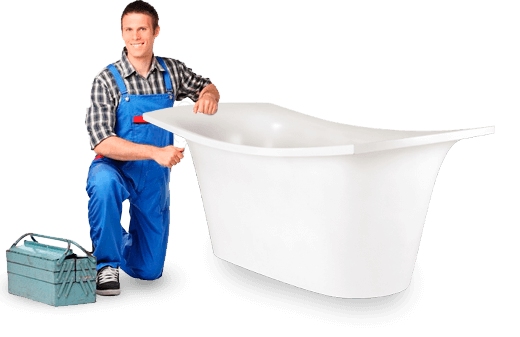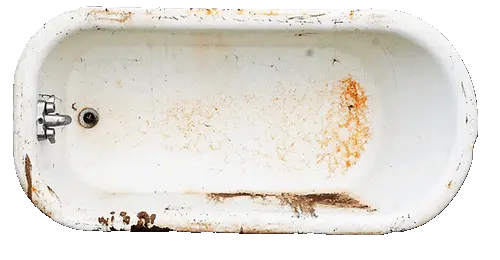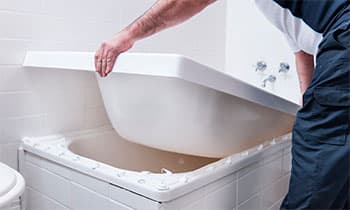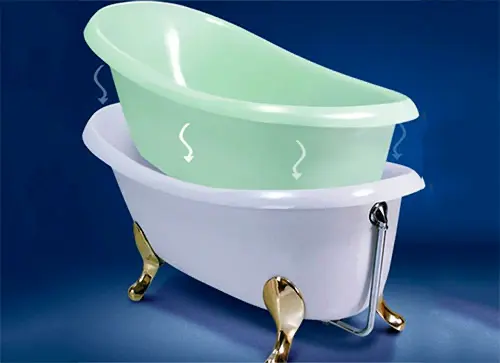Bathtub Liners
Bathtub repairing by gluing an plastic liner at first glance seems to be a simple process since no thorough preparation of the working surface is required. It is enough just to securely fix the acrylic overlay inside the existing tub and the bathroom will be transformed. The fixing of an bathtub insert is quite complex in execution, painstaking, and requires maximum attention to every detail.

To make the bathroom environment fresher, you do not always need a thorough repair. Sometimes it is just enough to renovate the bath, which, being the largest item in the room, attracts maximum attention.

If it is outdated, looks worn out is covered with scratches and chips, or has lost its gloss and bright white then its appearance will spoil the overall impression of the entire bathroom.
Seeing such a depressing view, many apartment owners solve the problem radically such as dismantling the old tub and replacing it with a new one.
Unfortunately, when dismantling and replacing the bathtub, it is rarely possible to avoid damaging the wall and floor coverings, and this means they need a redecoration of the bathroom.
To avoid unnecessary work, save time, and save the family budget, repairing the bathtub would be preferable. Some methods allow you to renew and improve the bath appearance, thereby delaying the need of purchasing a new one. One of the ways of repairing the bathtub involves the installation of an acrylic liner or «bathtub insert».
Bathtub Relining Cost
| Bathtub Liner | Pour-On Application | |
| Lifetime | ||
| Same Day Service? | ||
| Working Process | ||
| Removing Tiles | ||
| COST | $699 | $259 |


Tub liner is a product in the form of a bathtub that will be glued inside the already installed bathtub. The result is a perfectly white, glossy surface that has most of the advantages of an acrylic tub:
-
The bright whiteness and gloss create a perfect appearance, whereas the smoothness provides a pleasant feeling during usage;
-
It is easy to maintain and wash the acrylic surface due to the dirt repellent properties of the material;
-
The acrylic hygiene prevents the development of microorganisms and fungal spores thereby making the use of aggressive chemicals unnecessary;
-
Acrylic is safe and meets modern environmental requirements.
The service life of the liner depends on how well it was installed. The main problem with this type of material is its fragility and, as a result, cracks could appear due to improper load distribution or excessive pressure. This can be avoided by following all the rules and steps of fixing the bathtub liner.
The Installation Process of Bathtub Liners
To repair the old tub by installing an acrylic liner, you do not need to disassemble the old bathtub. Preserving the cast iron base with its reliability, stability and durability is one of the advantages of this method.
At the beginning of work with an plastic bathtub liner, the existing drain and overflow fittings are removed from the bath. Then the first row of tiles must be removed from the wall so that it does not interfere with the installation process. After that, you can start gluing the tub liner:
-
The washed and dried bathtub is treated with silicone sealant at the draining and overflowing places. This will eliminate the ingress of moisture into the cavity between the two surfaces and the development of mold;
-
Mark the places for the draining and overflow holes on the tub liner and then carefully drill them out. A clear alignment of the holes on the insert and the bathtub is one of the conditions for a well-executed work;
-
For gluing the acrylic overlay to the bath, a special foam is required. It is distributed over the surface in longitudinal and transverse lines so that there are no untreated places left and no excess is formed;
-
Without smearing or knocking down the applied material, the acrylic liner is carefully inserted into the bath. The sides should be properly sealed around the entire perimeter and align the drain and overflow holes to match;
-
If the insert is glued evenly and held securely, the fittings to the drain and overflow can be attached, after the excess sealant has been removed;
-
Lastly, the joints between the wall and the sides of the bathtub are sealed, and the decorative corner is glued.

At this point, the installation process itself can be considered complete, but it will not be possible to use the bathtub yet. The container must be filled as much as possible with water to adhere evenly and reliably to its weight over the entire contact area.
Experts say that you can use the bathtub after about 12 hours, but with some reservations. Within a few days, it is necessary to remove the mechanical load on the sides of the bathtub, in other words, they are no longer relied on. In addition, you do not need to apply too much weight to the surface.
If the installation of the plastic tub insert was made without errors, then the service life of the repaired bathtub can reach 10-15 years. An equally important factor is the correct choice of the tub liner itself. A durable product that will last for many years cannot be thinner than 1/2 inches in thickness.
Benefits of Bathtub Liners
-
Repairing the bath by installing a liner is much easier and faster than replacing it. The work is completed in a few hours, and the next day the bathroom can be used, adhering to some precautions;
-
Repairs using tub overlays are more affordable than purchasing a new bathtub, and the end result will not differ much;
-
The long-term result of the repair at a relatively low cost makes it profitable from the customer’s point of view.
Drawbacks of Bathtub Liners
-
Typically, plastic bath inserts have standard sizes and dimensions. It is not always possible to choose the one that is perfect for each particular bathtub.
If the customer’s bathroom has an unusually shaped bathtub, then the acrylic liner will have to be unpreferable in favor of other methods;
-
The installation process of the bath liner will not be complete without subsequent minor repairs of the bathroom.
You will need the services of a specialist who will be able to carefully remove, and then re-lay some tiles over the sides of the bathtub. This entails not only additional costs but also inconveniences;
-
Repairing the bath by gluing an acrylic liner will not significantly save money. Firstly, because a high-quality product will not be much cheaper than a new bathtub. Secondly, the accompanying minor repairs make the process even more expensive.
-
Bathtub overlay is quite fragile. If a heavy object falls into the bath, a crack may form, which will eventually make it impossible to use the bathtub. It is also not recommended to exceed the maximum load of 155 lbs, which is quite problematic for many families;
-
In case of poor installation, moisture can get into the space between the tub and the liner, which causes the appearance of mold and the development of microorganisms.
As a result, degradation processes begin, destroying the foam that keeps the liner on the surface of the bath. All this significantly reduces the service life of the bathtub insert;
-
It will take at least a week from the first time the specialist is called before the renovated bathroom can be used.
First, the specialist makes all the necessary measurements, then orders the liner for the desired configuration. When the product is available, the customer will be able to set a convenient time for work;
-
When installing a tub insert, mistakes often occur. If this occurs, the repaired bathtub will not last long for about 1-2 years. During this time, the liner may crack or deform;
-
The liner is always smaller in volume than the base bath. If initially, the size of the bathroom prevented the installation of a large tub, then after the repairs, it will become even smaller;
Fixing an plastic bathtub insert is not the best method in terms of benefits and durability. A lot of it depends on the skill of the specialist, so if you decide to fix a tub liner, you should contact specialists with experience and good recommendations.
Factors to Consider When Choosing a Bathtub Liner
There are a number of crucial aspects to take into account while selecting a bathtub liner. These consist of:
Material: Acrylic, PVC, and fiberglass are just a few examples of the materials that may be used to make bathtub liners. When choosing a material, take durability and upkeep requirements into account.
Custom Suit: Ensure that the bathtub liner you select is specifically designed to fit your current bathtub. By doing so, you can be sure that it will fit perfectly and give your bathroom the greatest possible appearance and feel.
Look for a bathtub liner that has a strong guarantee because this may provide you piece of mind and shield you from any potential flaws or issues.
When selecting a bathtub liner, cost is a crucial factor. The cost of bathtub liners might vary based on the manufacturer, size, and material. Compare prices and make sure the liner is within your budget before making a purchase.
In conclusion, homeowners wishing to update their bathrooms may find bathtub liners to be a practical and affordable option. They are a preferred alternative for many homeowners because to its accessibility, robustness, and customization possibilities. To make sure you get the ideal bathtub liner for your bathroom, you need take into account the points stated above.
Bathtub Reglazing vs. Bathtub Liners: Which is Right for You?
When deciding between bathtub reglazing and bathtub liners, it’s essential to consider cost, durability, and overall aesthetics. Each has its pros and cons, and the best choice often depends on individual preferences and needs.
-
Bathtub Reglazing:
Pros:
➕ Cost-effective compared to a full tub replacement.
➕ Variety of color choices.
➕ Gives an old tub a brand-new look.
➕ Quick process, typically finished in one day.
Cons:
➖ Surface can wear out, usually in 5-15 years, depending on usage and care.
➖ Cannot fix issues with tub structure.
-
Bathtub Liners:
Pros:
➕ Covers physical damage or staining in the original tub.
➕ Provides an extra layer, often improving insulation.
➕ Can change the look and feel of a tub without replacing it.
Cons:
➖ Typically more expensive than reglazing.
➖ Potential for water to get trapped between the liner and the tub, leading to mold or mildew.
➖ Less customizable in terms of appearance.
If you’re looking for a cost-effective and quick solution to refresh the look of your bathtub, reglazing might be the better option. However, if you’re aiming to address physical damages or improve insulation, a liner could be a more suitable choice. Regardless, both options are preferable to a full tub replacement in terms of cost and time. Consider your needs, budget, and desired outcome to make the right choice for your bathroom.
We have different methods of repairing bathtubs. We will provide you with information about the advantages and disadvantages of each of them and will be able to recommend the option that is most appropriate in each particular case. So, for example, a much more convenient, fast, and modern method of renewing and repairing tub is considered to be reglazing them using pour-on application.


